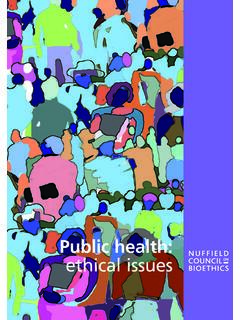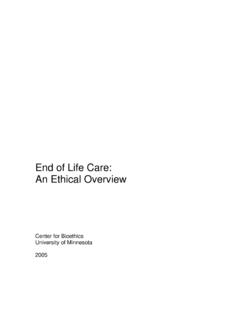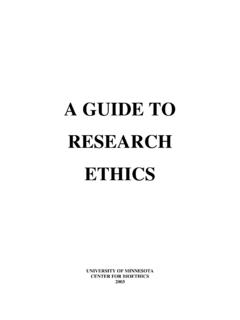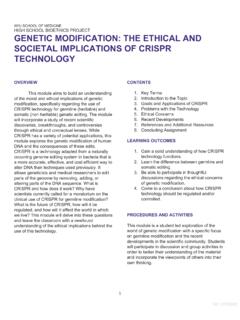Transcription of CLONING HUMAN BEINGS - Bioethics Research Library
1 CLONING HUMAN BEINGS . An Assessment of the Ethical Issues Pro and Con Commissioned Paper by Dan W. Brock, Brown University CONTENTS. Introduction E-3. Moral Arguments in Support of HUMAN CLONING E-4. A. Is There a Moral Right to Use HUMAN CLONING ? E-4. B. What Individual or Social Benefits Might HUMAN CLONING Produce? E-7. Moral Arguments Against HUMAN CLONING E-11. A. Would the Use of HUMAN CLONING Violate Important Moral Rights? E-11. B. What Individual or Social Harms Might HUMAN CLONING Produce? E-14. Conclusion E-20. References E-21. E-1. INTRODUCTION. The world of science and the public at large were both shocked and fascinated by the announcement in the journal Nature by Ian Wilmut and his colleagues that they had successfully cloned a sheep from a single cell of an adult sheep (Wilmut 1997).
2 Scientists were in part surprised, because many had believed that after the very early stage of embryo development at which differentiation of cell function begins to take place, it would not be possible to achieve CLONING of an adult mammal by nuclear transfer. In this process, the nucleus from the cell of an adult mammal is inserted into an ennucleated ovum, and the resulting embryo develops following the complete genetic code of the mammal from which the inserted nucleus was obtained. But some scientists and much of the public were troubled or apparently even horrified at the prospect that if adult mammals such as sheep could be cloned, then CLONING of adult humans by the same process would likely be possible as well.
3 Of course, the process is far from perfected even with sheep it took 276 failures by Wilmut and his colleagues to produce Dolly, their one success. Whether the process can be successfully replicated in other mammals, much less in humans, is not now known. But those who were horrified at the prospect of HUMAN CLONING were not assuaged by the fact that the science with humans is not yet there, for it looked to them now perilously close. The response of most scientific and political leaders to the prospect of HUMAN CLONING , indeed of Dr. Wilmut as well, was of immediate and strong condemnation. In the United States, President Clinton immediately banned federal financing of HUMAN CLONING Research and asked privately funded scientists to halt such work until the newly formed National Bioethics Advisory Commission could review the troubling ethical and legal implications.
4 The Director-General of the World Health Organization (WHO) characterized HUMAN CLONING as ethically unacceptable as it would violate some of the basic principles which govern medically assisted reproduction. These include respect for the dignity of the HUMAN being and the protection of the security of HUMAN genetic material (WHO 1997). Around the world similar immediate condemnation was heard, as HUMAN CLONING was called a violation of HUMAN rights and HUMAN dignity. Even before Wilmut's announcement, HUMAN CLONING had been made illegal in nearly all countries in Europe and had been condemned by the Council of Europe (Council of Europe 1986). A few more cautious voices were heard, both suggesting some possible benefits from the use of HUMAN CLONING in limited circumstances and questioning its too quick prohibition, but they were a clear minority.
5 In the popular media, nightmare scenarios of laboratory mistakes resulting in monsters, the CLONING of armies of Hitlers, the exploitative use of CLONING for totalitarian ends as in Huxley's Brave New World, and the murderous replicas of the film Blade Runner, all fed the public controversy and uneasiness. A striking feature of these early responses was that their strength and intensity seemed to far outrun the arguments and reasons offered in support of them they seemed often to be gut level emotional reactions rather than considered reflections on the issues. Such reactions should not be simply dismissed, both because they may point us to important considerations otherwise missed and not easily articulated, and because they often have a major impact on public policy.
6 But the formation of public policy should not ignore the moral reasons and arguments that bear on the practice of HUMAN CLONING these must be articulated in E-3. order to understand and inform people's more immediate emotional responses. This paper is an effort to articulate, and to evaluate critically, the main moral considerations and arguments for and against HUMAN CLONING . Though many people's religious beliefs inform their views on HUMAN CLONING , and it is often difficult to separate religious from secular positions, I shall restrict myself to arguments and reasons that can be given a clear secular formulation and will ignore explicitly religious positions and arguments pro or con.
7 I shall also be concerned principally with CLONING by nuclear transfer, which permits CLONING of an adult, not CLONING by embryo splitting, although some of the issues apply to both (Cohen and Tomkin 1994). I begin by noting that on each side of the issue there are two distinct kinds of moral arguments brought forward. On the one hand, some opponents claim that HUMAN CLONING would violate fundamental moral or HUMAN rights, while some proponents argue that its prohibition would violate such rights. On the other hand, both opponents and proponents also cite the likely harms and benefits, both to individuals and to society, of the practice. While moral and even HUMAN rights need not be understood as absolute, that is, as morally requiring people to respect them no matter how great the costs or bad consequences of doing so, they do place moral restrictions on permissible actions that appeal to a mere balance of benefits over harms.
8 For example, the rights of HUMAN subjects in Research must be respected even if the result is that some potentially beneficial Research is made more difficult or cannot be done, and the right of free expression prohibits the silencing of unpopular or even abhorrent views; in Ronald Dworkin's striking formulation, rights trump utility (Dworkin 1978). I shall take up both the moral rights implicated in HUMAN CLONING , as well as its more likely significant benefits and harms, because none of the rights as applied to HUMAN CLONING is sufficiently uncontroversial and strong to settle decisively the morality of the practice one way or the other. But because of their strong moral force, the assessment of the moral rights putatively at stake is especially important.
9 A further complexity here is that it is sometimes controversial whether a particular consideration is merely a matter of benefits and harms, or is instead a matter of moral or HUMAN rights. I shall begin with the arguments in support of permitting HUMAN CLONING , although with no implication that it is the stronger or weaker position. Moral Arguments in Support of HUMAN CLONING A. Is There a Moral Right to Use HUMAN CLONING ? What moral right might protect at least some access to the use of HUMAN CLONING ? Some commentators have argued that a commitment to individual liberty, as defended by J. S. Mill, requires that individuals be left free to use HUMAN CLONING if they so choose and if their doing so does not cause significant harms to others, but liberty is too broad in scope to be an uncontroversial moral right (Mill 1859; Rhodes 1995).
10 HUMAN CLONING is a means of reproduction (in the most literal sense), and so the most plausible moral right at stake in its use is a right to reproductive freedom or procreative liberty (Robertson 1994a; Brock 1994). Reproductive freedom includes not only the familiar right to choose not to reproduce, for example by means of contraception or abortion, but also the right to reproduce. The right to reproductive freedom is E-4. properly understood to include as well the use of various artificial reproductive technologies, such as in vitro fertilization (IVF), oocyte donation, and so forth. The reproductive right relevant to HUMAN CLONING is a negative right, that is, a right to use assisted reproductive technologies without interference by the government or others when made available by a willing provider.








